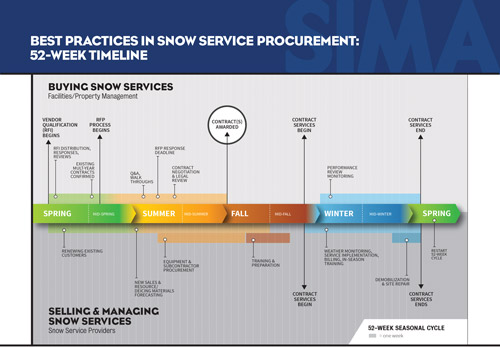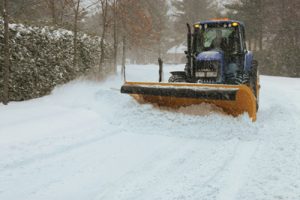



Source: www.TurfMagazine.com
By Phill Sexton
Who in their right mind thinks of planning for winter in July? In my own career, I’ve learned by experience and from other professionals to consider July 5th the start of the winter planning season. For some “snow only” firms throughout North America, July might be considered a late start preparing for the next winter season. But, whether you are a “snow only” operator or a landscape or turf management company providing snow and ice services to a subset of your clientele, the standards for resource procurement, training, and preparation are the same.

The Snow & Ice Management Association (SIMA) has developed a timeline for winter operations, and their clients—typically facility managers and property managers. Utilizing this timeline (see opposite page) as an industry standard will help you to organize your sales and operational responsibilities into categories of focus.
Setting Up Sales
Renewals of existing contracts are best to initiate at the tail end of the existing snow season. Yes, a common reason for not doing this is: “My clients don’t want to talk about snow until later in the summer or in the fall.” This then gets pushed till the beginning of the next season. My experience has been when you initiate the renewal process at the end of the current season and give clients an incentive for renewing during that time period, more often than not it’s what the client wants. You simply need to have the confidence to do this.
RFPs (requests for proposals) are normally sent out by facility managers and property managers between late summer and early fall—and oftentimes much later. If there are properties you know you want the opportunity to bid, be confident to ask for the RFP rather than wait for it.
Contract award dates have been a concern for years. Of particular concern is the quantity of late awarded or renewed contracts that require weeks, if not months, worth of preparation to properly equip the property and remain price competitive. Although snow and ice service providers have become accustomed to allowing clients dictate when award decisions are made, it is the industry’s responsibility to educate clients who may not understand the supply side economics of a snow and ice management business.

Optimizing Operations
Workforce recruiting is by far the number one concern for a winter services operation. Recruiting now for the upcoming winter season is a critical step. Be creative about where you are advertising available positions. Try to think beyond typical means, including partnering up with other part-time industries. Think about it. Many times, when we are busiest during a snowstorm event, other industries take the day off, and these include roofing, car washes, and other exterior service industries. And there are other professional industries that work shift schedules. These professionals are often looking for means of supplementing their income. Some of the professions to think about engaging with for part-time team members include: fire and rescue, corrections, law enforcement, and security professionals.
Materials acquisition and inventory are pre-season processes and investments that are paramount to any snow and ice management operation. All too often snow and ice contractors either wait until the beginning of the season, or they order as needed. In either case, you are paying a premium price for materials, and negatively contributing to the supply and demand chain. When you don’t “pre-order” your projected annual salt inventory, you are causing “salt shortages” as have occurred in several places throughout North America in the past decade, including the 2018-19 season.
Equipment purchasing and rental agreements are best completed mid-July through mid-August to allow plenty of time for supply chain to accommodate your needs and remain price competitive. Similar to the materials acquisition process, there is an appropriate lead time for ordering, producing, repairing, or upfitting equipment that fits within the different time constraints and requirements of the supply chain.
Measuring and tracking your materials usage and productivity is an opportunity that only a small percentage of members of the snow and ice management industry is taking advantage of. By measuring, not only will you find waste in material usage and snow plowing operation, the fact you are measuring your results will enable you to find the gaps of improvement opportunities. GPS time tracking and salt application tracking are the two most basic items that need to be measured and always present room for improvement.

Furthermore, there are methods and technology that allow you to automate tracking and documenting your level of service (LOS) that includes real time and historical pictures and site conditions. This level of measuring then furthers the ability to automate and improve the accuracy of your service verification process.
Sustainable Winter Management (SWiM®)
As an industry, we need to be keenly aware that what we do operationally causes unintended consequence, both economically and environmentally. While we have a responsibility to manage snow and ice conditions, as professionals we are equally responsible to understand how our efforts impact clients’ budgets.
Furthermore, managing snow and ice conditions can negatively affect the environment. What I’m speaking to mostly is our use of salt. How we use salt and how much of it we use impacts not only the financial picture, but also the environment due to the fact that salt may pollute freshwater resources as a result of non-point source runoff.
Regulation of road salt application is already being proposed throughout several areas of the country, particularly in the Great Lakes region of North America. Several more regions already offer voluntary salt application training programs. Within the next five to 10 years, it’s likely voluntary and/or required training will exist in most states where road salt use is more common and where salt pollution of freshwater resources have been identified at an urgent level.
Guidelines are available to help contractors or property owners and municipalities adopt and follow a Sustainable Winter Management (SWiM®) program. SWiM includes policies that enable standards of practice including: measuring, calibration, prevention, analysis, improvement and optimization.
 Sexton is founder and managing director of WIT Advisers and industry adviser to the Snow & Ice Management Association (SIMA). WIT Advisers administers the Sustainable Winter Management (SWiM™) program and certifications for properties. Sexton also serves as adjunct professor at the Center of Agriculture and Natural Resources of the State University of New York (SUNY) at Cobleskill. He holds degrees in agriculture, horticulture, and business economics from the State University of NY and a master’s degree in Sustainability from Harvard University where he focused his studies on corporate innovation and sustainability and researching salt use by the winter management industry.
Sexton is founder and managing director of WIT Advisers and industry adviser to the Snow & Ice Management Association (SIMA). WIT Advisers administers the Sustainable Winter Management (SWiM™) program and certifications for properties. Sexton also serves as adjunct professor at the Center of Agriculture and Natural Resources of the State University of New York (SUNY) at Cobleskill. He holds degrees in agriculture, horticulture, and business economics from the State University of NY and a master’s degree in Sustainability from Harvard University where he focused his studies on corporate innovation and sustainability and researching salt use by the winter management industry.
Do you have a comment? Share your thoughts in the Comments section below or send an e-mail to the Editor at acosgrove@groupc.com.